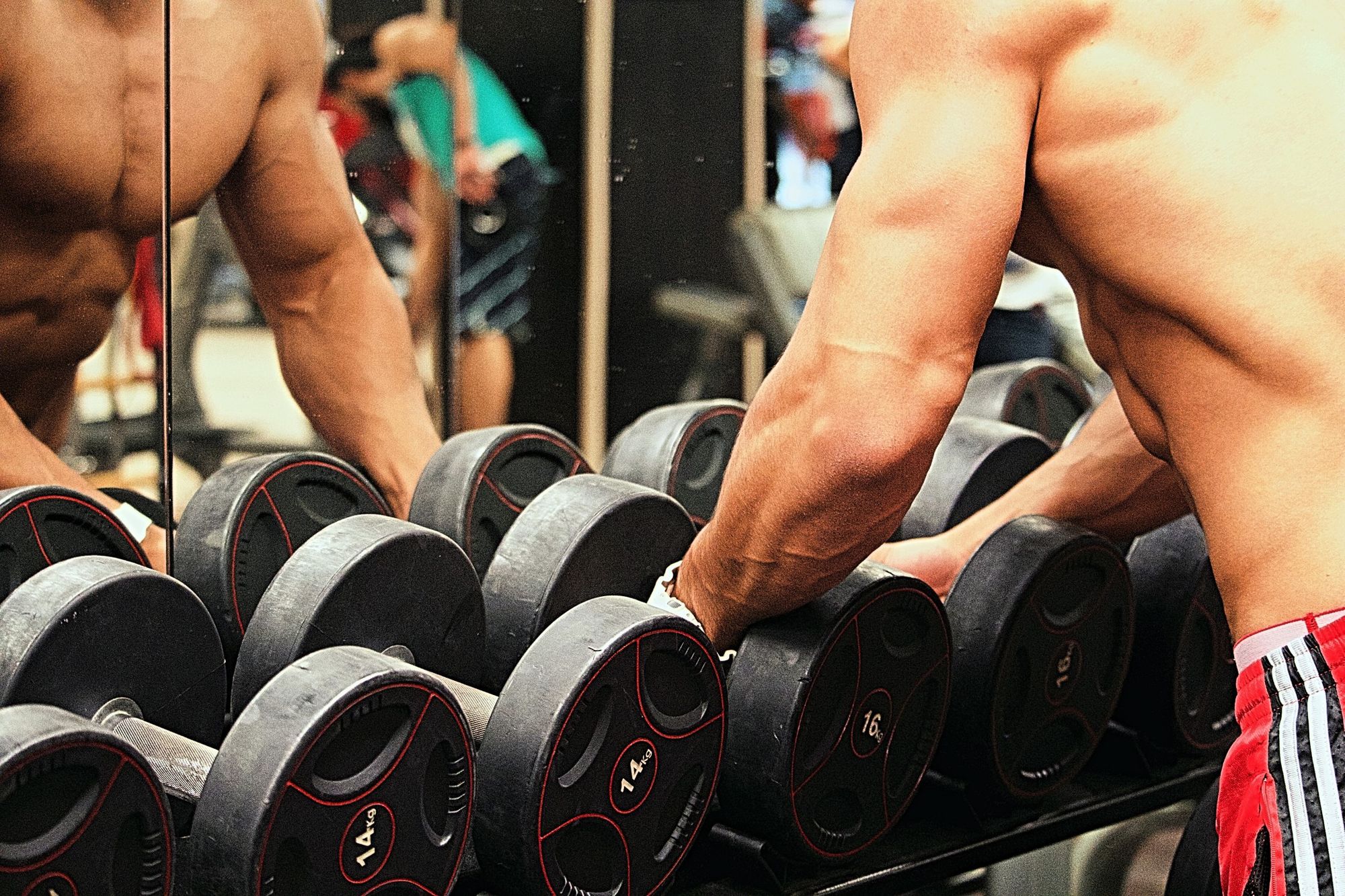Here's Why Your Arms Are Not Growing (Easy Fix)
The arms, a muscle group that gets the most attention - so it can get pretty disheartening if you are struggling to add mass to your guns. Plus, there's always that niggling thought: "Am I leaving some gains on the table?"

Here’s a question: what’s the first muscle group someone usually asks to see the moment you let them know you’re a big fan of lifting iron? ?
Well, yes – the arms. Rarely would you ever encounter someone who goes, “Oh hell, yes! Show me that lat spread of yours!" No, it's usually the arms that get the most attention. And for all who're struggling to add mass to their guns, it can get pretty disheartening whenever said person seems unimpressed with the thickness of your arms. Not that it matters, of course. But, still, there's always that niggling thought: "Am I leaving some gains on the table?"
Well, read this article to find out if you’re accidentally killing your arms gains by making the following three arms day mistakes.
#1 – You’re not varying your exercise order
Muscles that are trained earlier show superior growth
If you’re like most people, you’ll tend to train your biceps only after you’ve worked out your back, and your triceps after you’ve trained chest and delts. Well, that's a big mistake. Why? Well, that's because research has consistently shown that muscle growth is always better in those muscle groups that are trained early on in the workout. So, if you're treating your arm muscles as a 'tag-on' in your workout, you won't be able to hit them with sufficient intensity – you're already tired from all the heavy lifting you did in the first part of your workout!
Shuffle your arm exercises around
Accordingly, the solution to this arms day mistake is simple: you should, as much as you can, prioritize the development of your arms if you want them to grow. Instead of always scheduling them at the back of your workout, why don’t you try completing them first? Or, better yet, carve out an additional day just to train them?
Now, this can also explain why you could be seeing muscle imbalance between your biceps and triceps. Always training biceps before your triceps can lead to the former overpowering the latter over time – in addition to messing with your ideal aesthetic look, this imbalance can also cause you to be more prone to injuries. And you don’t want that. So, to ensure a more balanced development of both muscles over time, alternate between the muscle you start with every week. Maybe biceps this week, then triceps the next.
#2 – You’re not resting long enough between sets
If you always feel like you're short of breath in between sets, you’re probably doing something wrong. That is, you're not clocking in enough rest time before starting on a new set. Yes, you may feel like you're pushing yourself harder, and – is it you, or are your arms incredibly pumped? But here's the thing: you're not achieving the results you think you are.
Resting for 2 minutes between sets is ideal
According to a 2016 systematic review, resting at least a minute between sets led to almost 40% greater muscle growth in comparison to resting just under a minute. Now, you may be thinking, “At least a minute? That’s a huge range.” Well, here’s something more specific. Recent studies suggest that for single-joint exercises (like most arms exercises), you’d want to shoot for roughly 2 minutes of rest between sets. Hitting 2 minutes of rest not only enables you to achieve maximal muscle growth, but it can also boost your strength and workout volume.
So, if you're guilty of always rushing into a new set of barbell curls even though you're still huffing and puffing from the previous, you'd be better off by laying off the weights for just 2 minutes. Think about it: for gains, that's not a big ask, isn't it?
#3 – You’re not incorporating exercises with different arm angles
So, you've shuffled your exercise order, and you're now fastidiously counting down every second of your 120-second long rest period. You’ve even worked on your mind-muscle connection. Three months on, and you’re still not seeing significant changes in your biceps and triceps. What gives? Assuming that you’re indeed progressively overloading on your exercises, another mistake you could be making is in neglecting to include exercises that train your arms in different angles.
An easy way of knowing if you're committing this mistake is to think back on your last arms day. If your elbows were always by your side throughout all of your exercises – no matter triceps or biceps, then you've probably found the reason behind the suboptimal growth of your arms. In case you didn't know, your biceps and triceps are composed of multiple heads, which are then selectively emphasized based on arm angles during specific movements.
Workouts with varying arm angles show more significant anabolic response
To illustrate the importance of including a mix of arms exercises that have varying arm angles, let’s take a look at the findings of a 2019 paper. In this particular study, the researchers looked at two different conditions:
- Performing nine sets of the traditional barbell biceps curl, where the elbows are held by the side
- Performing three sets of curls at three different arm angles
The result? Well, as you might already have guessed, individuals in the second condition experienced significantly higher overall activation from the session in comparison to those in the first! In the same line of reasoning, these individuals would then be more likely to experience faster biceps growth over time!
How can I bring this into my next arms day?
Here’s what you can do:
- Biceps
- A curl where your elbows are behind your body (Incline dumbbell curl)
- A curl where your elbows are by your side (Traditional barbell bicep curl)
- A curl where your elbows are in front of your body (Preacher curl)
- Triceps
- An exercise where you hold your elbows overhead (Skullcrusher)
- An exercise where your elbows are by your side (Triceps pushdown)
- One pressing movement (Pushup)
Takeaway
Hopefully, you’ve managed to identify the culprit responsible for slowing your arms gains and now know how to rectify the mistake you’re making. But – what if you suspect that your arms may not be growing because you’re not executing the exercises with the proper form? Before you go shelling out thousands of dollars for a personal trainer, why not download the GymStreak app?
The app includes a comprehensive library of proper lifting techniques for exercises that you can refer to and also helps design a personalized workout program based on your fitness goals through its AI functionalities! Besides, it's got a swanky new update, and it's got some exciting features you don't want to miss out on (including customizable workouts)!
References
Barakat, C., Barroso, R., Alvarez, M., Rauch, J., Miller, N., Bou-Sliman, A., & De Souza, E. (2019). The Effects of Varying Glenohumeral Joint Angle on Acute Volume Load, Muscle Activation, Swelling, and Echo-Intensity on the Biceps Brachii in Resistance-Trained Individuals. 7. https://doi.org/10.3390/sports7090204
Grgic, J., Lazinica, B., Mikulic, P., Krieger, J., & Schoenfeld, B. (2017). The effects of short versus long inter-set rest intervals in resistance training on measures of muscle hypertrophy: A systematic review. European Journal of Sport Science, 17, 1–11. https://doi.org/10.1080/17461391.2017.1340524
Schoenfeld, B. J., Pope, Z. K., Benik, F. M., Hester, G. M., Sellers, J., Nooner, J. L., … Krieger, J. W. (2016). Longer Interset Rest Periods Enhance Muscle Strength and Hypertrophy in Resistance-Trained Men. Journal of Strength and Conditioning Research, 30(7), 1805–1812. https://doi.org/10.1519/JSC.0000000000001272
Senna, G. W., Willardson, J. M., Scudese, E., Simão, R., Queiroz, C., Avelar, R., & Martin Dantas, E. H. (2016). Effect of Different Interset Rest Intervals on Performance of Single and Multijoint Exercises With Near-Maximal Loads. The Journal of Strength & Conditioning Research, 30(3), 710. https://doi.org/10.1519/JSC.0000000000001142
Simão, R., de Salles, B. F., Figueiredo, T., Dias, I., & Willardson, J. M. (2012). Exercise Order in Resistance Training. Sports Medicine, 42(3), 251–265. https://doi.org/10.2165/11597240-000000000-00000

